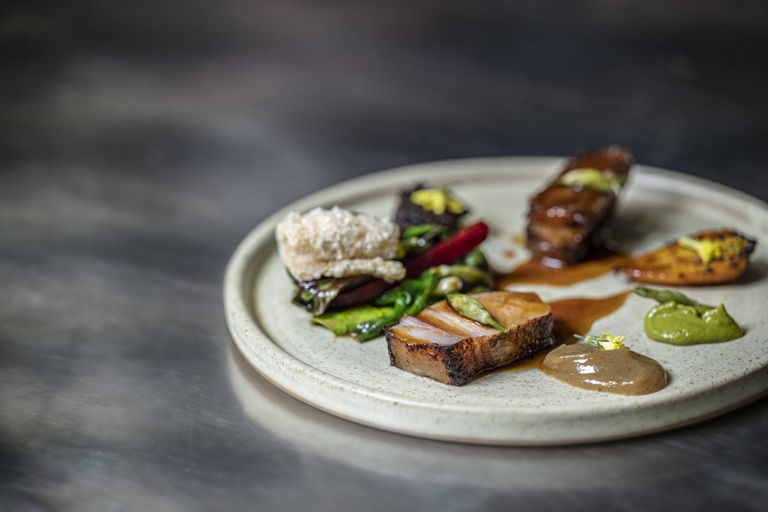Pork with vegetables from the farm

- 8
- 4 hours
This recipe takes a huge amount of work to pull off and you’ll need to begin days in advance, but for those looking for a true challenge, this pork dish from Will Devlin is an absolute masterclass in all manner of techniques. While it may look intimidating it doesn’t require any special equipment and a lot of the time involved comes from curing and slow-cooking the various pork cuts. The recipe is written so you can get as much done in the days leading up to serving – on the actual day itself, most of the hard work is already done. At the very least, the recipe is a fascinating insight into how much work Will puts into dishes at The Small Holding.
Will says: ‘We don’t serve a lot of meat at the restaurant, but when we do, the dish is from the whole animal and nothing is wasted. This dish has several pork elements and is a real celebration of a very fine animal. We rear our own pigs at The Small Holding meaning we can give them everything they need for a happy life and to display all their natural behaviours. It also means, to a certain extent, we can control the flavour and fat content of the meat as, for part of their time with us, the pigs live under a huge oak tree and can eat the fallen acorns.’
Ingredients
Metric
Imperial
Pear ketchup
- 1l water
- 30g of salt
- 8 small pears
Pork belly brine
- 2l water
- 200g of caster sugar
- 300g of salt
- 6 juniper berries
- 6 cloves
- 6 black peppercorns
- 2 bay leaves
Pork belly
- 1 pork belly, (approx. 2-3kg), ideally from the thicker end, skin-on and bone-in
- 3l pork fat, melted, or vegetable oil, to confit
Pork shoulder
- 1 pork shoulder, small
- 2l chicken stock, ideally homemade
- 50g of flat-leaf parsley, finely chopped
- 3 gherkins, large, finely chopped
- 4 tbsp of capers, chopped
- 60ml of apple cider vinegar, or to taste
- sea salt
- freshly ground black pepper
Pork loin
- 600g of pork loin
- 50g of koji grains, or flaky sea salt
Pork sauce
- 1 dash of vegetable oil
- 500g of pork trimmings
- 8 shallots, sliced
- 1 garlic bulb, cloves peeled
- 2 apples, roughly chopped
- 50g of mixed herbs, such as thyme and sage
- 1 knob of unsalted butter
- 568ml of dry cider, (1 pint)
- 2l chicken stock, ideally homemade
- 2l veal stock, ideally reduced and intense – Will makes his own but sourcing some from a top-quality supplier is fine
- 1 tbsp of apple cider vinegar
Green mustard
- 100g of Dijon mustard, Will makes his own but shop-bought is fine
- 50g of mustard greens, washed and roughly chopped (you could also use Jack-by-the-Hedge leaves if in season)
Vegetables
- 1 bunch of baby carrots, washed and trimmed (reserve the tops if they have them)
- 1 bunch of rainbow chard, washed and trimmed
- 1 bunch of spring onions, washed and trimmed
- 1 knob of unsalted butter
- 1 handful of wild garlic leaves
- 2 garlic cloves, bashed with skins left on
- 3 sprigs of summer savoury, or thyme
- chive flowers, and/or pickled wild garlic buds, to garnish (optional)
Method
- 30g of salt
- 1l water
- 8 small pears
- 2l water
- 200g of caster sugar
- 300g of salt
- 6 juniper berries
- 6 cloves
- 6 black peppercorns
- 2 bay leaves
- 1 pork belly, (approx. 2-3kg), ideally from the thicker end, skin-on and bone-in
- 3l pork fat, melted, or vegetable oil, to confit
- 1 pork shoulder, small
- 2l chicken stock, ideally homemade
- 50g of flat-leaf parsley, finely chopped
- 3 gherkins, large, finely chopped
- 4 tbsp of capers, chopped
- 60ml of apple cider vinegar, or to taste
- sea salt
- freshly ground black pepper
- 600g of pork loin
- 50g of koji grains, or flaky sea salt
- 1 dash of vegetable oil
- 500g of pork trimmings
- 8 shallots, sliced
- 1 garlic bulb, cloves peeled
- 2 apples, roughly chopped
- 50g of mixed herbs, such as thyme and sage
- 1 knob of unsalted butter
- 568ml of dry cider, (1 pint)
- 2l chicken stock, ideally homemade
- 2l veal stock, ideally reduced and intense – Will makes his own but sourcing some from a top-quality supplier is fine
- 100g of Dijon mustard, Will makes his own but shop-bought is fine
- 50g of mustard greens, washed and roughly chopped (you could also use Jack-by-the-Hedge leaves if in season)
- 1 bunch of baby carrots, washed and trimmed (reserve the tops if they have them)
- 1 bunch of rainbow chard, washed and trimmed
- 1 bunch of spring onions, washed and trimmed
- 1 knob of unsalted butter
- 1 handful of wild garlic leaves
- 2 garlic cloves, bashed with skins left on
- 3 sprigs of summer savoury, or thyme
- chive flowers, and/or pickled wild garlic buds, to garnish (optional)
- 1 tbsp of apple cider vinegar
Get in touch
Please sign in or register to send a comment to Great British Chefs.


